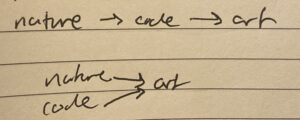Casey Reas’ Eyeo talk on chance operations
This talk challenged my belief that code is one of the opposites of nature. I used to think that people could employ code in an attempt to replicate nature: humans (“natural” organisms) ordering a computer (an “unnatural” object) to create art. However, Reas’ talk made me realize that perhaps code and nature could operate on the same level. They both operate on certain core principles to create patterns that are then interpreted by humans as art. There is not so strict of a distinction between the natural and the artificial. This concept reminded me of Donna Haraway’s Cyborg Manifesto, in which she blurs line between humans and non-human organisms, and between humans and the technologies/systems we use.
 (the top line is my previous belief, and the bottom line is the new concept introduced by the talk)
(the top line is my previous belief, and the bottom line is the new concept introduced by the talk)
I think that’s Reas, as a digital artist, is biased towards portraying his own profession in a positive light, in the sense that he is in a position to make meaning out of abstract art. Some of the examples he showed, like the picture created by an artist dropping pieces of paper on the floor and leaving them there, made me wonder if such pieces are only considered art because of who created it and who is interpreting it. Both the artist and the commentators are likely already established within the rather gate-kept art world. If a child in kindergarten dropped some pieces of paper on another piece of colored paper and then painted the result, I doubt that people would pay the same respect in their analysis — they’d probably tell the child to clean up the floor. This points to power dynamics in the creative world, in which people with certain identities are more likely to be taken seriously. I am not trying to discount the importance of artist’s intention and concept, only posing the question: are certain artworks only considered art because the people creating them are already seen as artists?
I also want to comment on Reas’ latest project trying to reveal the algorithmic structures behind artworks. I feel that there is an ideological undertone throughout the whole talk that we should aspire to gain an algorithmic understanding of the world and of art, which I don’t know if I agree with. Especially with the rise of AI and the way it is impacting artists’ rights and pay, it is worthwhile to think about how computers’ ability to emulate randomness may come with both benefits and consequences.
